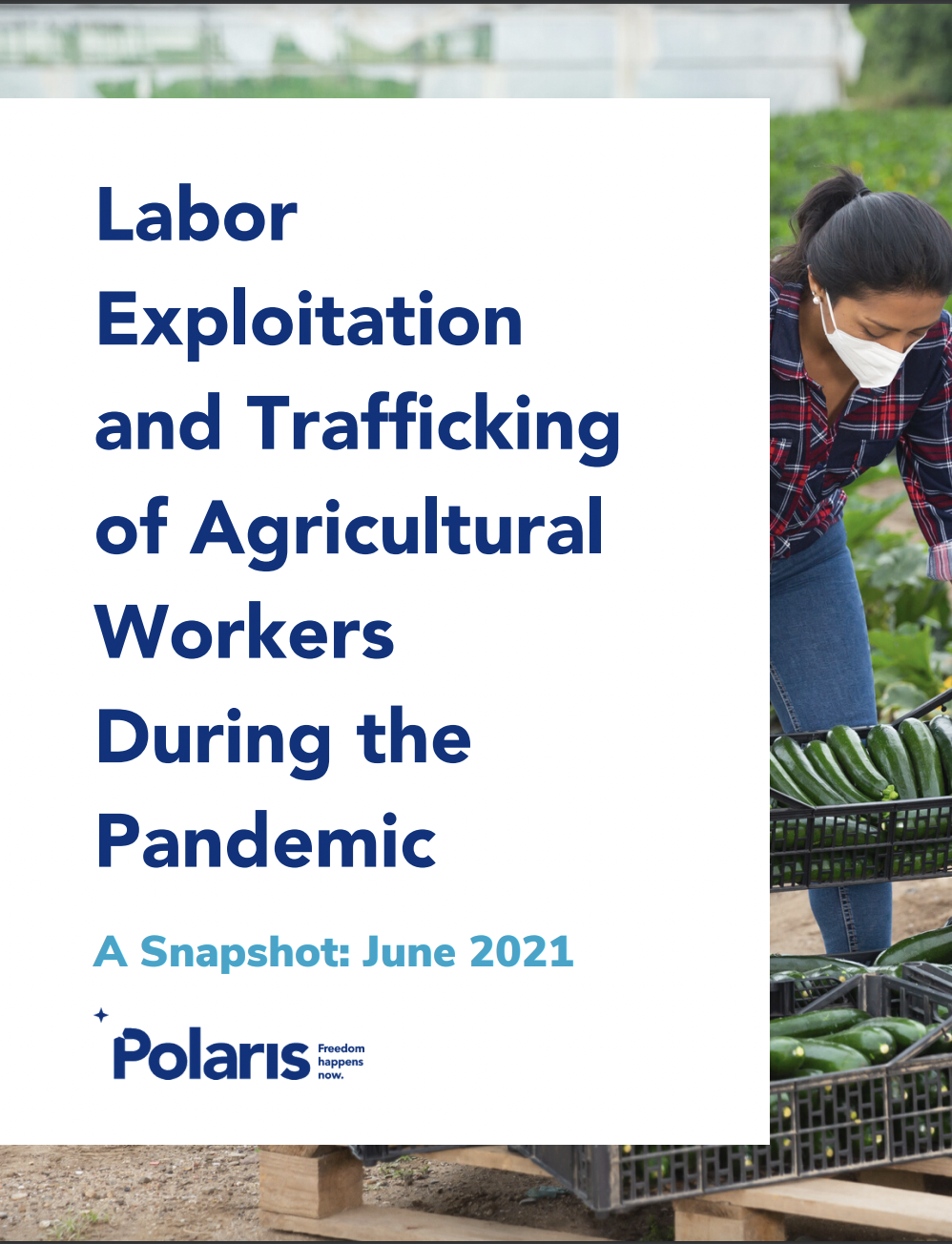
Labor Exploitation and Trafficking of Agricultural Workers During the Pandemic
Background
Over the last year, Polaris examined data from the U.S. National Human Trafficking Hotline to determine the potential impact of the COVID19 pandemic on human trafficking in the United States. The effort involved comparing the volume of identified likely trafficking situations in separate periods before and during the pandemic response. In addition, differences in the demographics and other characteristics of situations were examined (see box below). It is important to note the limitations of this analysis. First, this is an exploration of correlation and not causation, meaning that the findings are not proof that the changes are caused by the COVID-19 pandemic. Next, the Trafficking Hotline exists to assist victims and survivors of human trafficking and data is gathered only for the purpose of providing that assistance; therefore, every person who makes contact with the Trafficking Hotline is not asked the exact same questions. This contributes to the possible measurement variation. This brief is the third in a planned series presenting timely analysis and evidence to guide efforts to respond to emerging needs as a result of the COVID-19 pandemic.
Time Periods
- Pre-shelter-in-place 2019: April 1st – September 30th, 2019
- Pre-shelter-in-place 2020: October 1, 2019 – March 31, 2020
- Post-shelter-in-place 2020: April 1st – September 30th, 2020
The analysis compares a six-month post-shelter-in-place period to two deliberately chosen pre-shelter-in-place periods, based on the orders to stay home on March 15th in San Francisco, CA. By March 30th, most states that eventually enacted a shelter in place order had done so. Independent sample t-tests were used to examine if differences between two time periods are likely to represent an actual difference rather than one that arose as a result of chance variations. In this analysis, significant findings were noted if differences against both time pre-shelter-in-place periods were significant at p<0.05 levels (a standard level used in social science research, indicating a less than 5 percent probability that the difference is due to chance). Chi-square statistics were also used to examine for significant differences in the proportions of situations and victims of trafficking of certain characteristics.
Findings
Some of these changes were not significant since the number of cases reported to the hotline in these categories are already small resulting in small sample sizes with reduced power to detect significant changes. The analysis found possible decreases in reports of labor trafficking in key industries with one major exception: Agriculture. In agriculture, there is some evidence that trafficking and exploitation may have in fact increased among these workers – individuals deemed “essential” during the global pandemic. The most notable decrease in reports of trafficking came in the hospitality industry, which saw a drop of between 30 and 60 percent over comparable non pandemic periods. While it is hard to prove with our data, it is likely that this can be attributed in large part to a significant slowdown of economic activity and in some situations, a complete shutdown of this segment of the economy. In addition, there were some indications, though not statistically significant, of reductions in situations related to commercial cleaning and domestic work. These findings are not a suggestion that trafficking has declined permanently in these sectors – only that the overall decrease in economic activity in these sectors may have also contributed to a decrease in the number of contacts about trafficking in these sectors.
The agriculture sector, by contrast, remained up and running to the extent possible. Much of that sector is staffed by immigrant workers, many of whom come to the country on legal, temporary work visas called H-2A visas. Data from the Trafficking Hotline has long shown that workers in this country on certain kinds of legal, temporary work visas are disproportionately represented amongst victims we learn about. The situation appears to have been exacerbated during the pandemic. The daily number of labor trafficking and exploitation situations reported to the Trafficking Hotline that had at least one victim with an H-2A visa doubled for the 6-month period during the pandemic. As a result, the proportion of reported labor trafficking victims with an H-2A visa went up significantly from approximately 11% to 25%.
Available data on likely victims of labor trafficking from the last two years (October 2018 through September 2020) shows that H2A visa holders whose demographics are known were male (98%), adults (100%), and of Hispanic or Latino origin (99%). Almost all of them reported fraudulent recruitment tactics that included false promises or job offer advertisements. During their exploitative employment, almost all likely victims experienced some type of coercion (99%) and fraud (94%).
The pandemic has aggravated some of these experiences. The proportion of likely victims of labor trafficking who held H-2A visas and experienced fraud during their employment went up from approximately 80 percent prepandemic to almost 100 percent, mostly a result of increases in the use of debt and quotas. In addition, while there were no significant changes in the overall proportions of victims experiencing coercion, those that experienced denial of their daily needs, stalking and threats to harm them or their families increased. Finally, those who reported being denied medical care increased significantly from less than 20 percent prepandemic to 34 percent post-pandemic.
Read more here.
